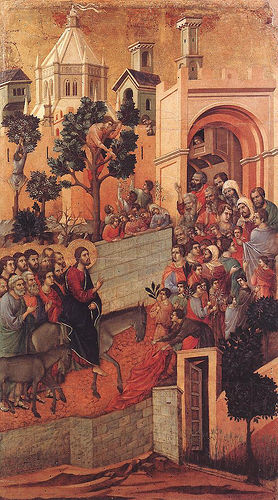On Palm Sunday this week’s picture is Christ’s Entry into Jerusalem, a panel from the great polyptych known as the Maesta, which was created by Duccio di Buoninsegna and his workshop in Siena between 1308 and 1311. Using colour, line and considerable ingenuity the painter has fleshed out the New Testament accounts such as Matthew, Chapter 21:
“And when they drew nigh unto Jerusalem, and were come to Bethphage, unto the Mount of Olives, then sent Jesus two disciples, Saying unto them, Go into the village over against you, and straightway ye shall find an ass tied, and a colt with her: loose them, and bring them unto me. And if any man say ought unto you, ye shall say, The Lord hath need of them; and straightway he will send them… And the disciples went, and did as Jesus commanded them, and brought the ass, and the colt… and they set him thereon. And a very great multitude spread their garments in the way; others cut down branches from the trees, and strawed them in the way. And the multitudes that went before, and that followed, cried, saying, Hosanna in the highest.”
Duccio rose to the challenge of recreating a crowd scene with a cast of thousands on a panel of wood no bigger than a school atlas. Accompanied by the huddled mass of his disciples, Jesus rides up a roughly cobbled incline towards a Jerusalem that has been reimagined as a fourteenth-century Tuscan hilltop city – a place which, with its fortified city gate, slender towers and polygonal gothic marble baptistry was probably intended to put the artist’s Sienese audience in mind of their own home town. While Christ raises his right hand in benediction, the forty or so citizens whom Duccio has arranged to stand...

ITP 51: Christ’s Entry into Jerusalem, by Duccio di Buoninsegna
08-04-2001

